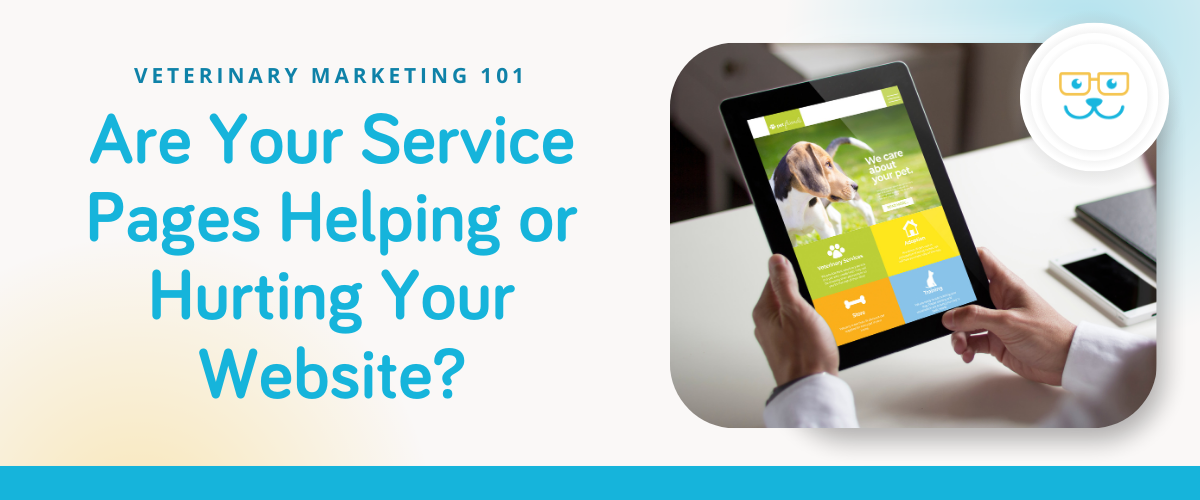Are Your Service Pages Helping or Hurting Your Website?
In today’s world, everyone turns to their computer or phone for instant information. More often than not, your website will be a major part of your practice's first impression and the source of truthful information about your business. This is why a functional, attractive, easy-to-navigate, and, most importantly, helpful website isn’t just a “good idea” it’s imperative.
Pet owners aren't likely to pick your practice simply based on your homepage alone. Any good pet owner is bound to do their due diligence by clicking around and exploring what you have to offer before making an appointment – that's why insightful and optimized service pages are so important in the veterinary industry.
If you’re wondering if your current service pages are helping or hurting your website, you’ve come to the right place. In this blog, we'll cover what a veterinary service page is, how you can tell if yours are effective, and what service page features can help improve your conversion rates and user experience. We are here to share a few secrets to making your service pages one of your hardest-working salespeople.

What Is a Service Page?
Let's start with the basics. A service page is a dedicated section on your website outlining your veterinary services. It's essentially a virtual brochure that provides detailed and specific information about the medical treatments, preventive care, and other services your clinic provides for pets. These pages serve as an informational bridge between your potential clients and the services you offer, guiding them toward making informed decisions and letting them know exactly what your clinic does and does not offer.
While other practices or businesses may utilize different designs, layouts, or organizational structures for their service pages, the purpose remains the same – ensuring that both potential and existing patients understand what your practice is able to offer and what aspects of your care best suit their pet’s needs.
3 Signs of Success: KPIs & Stats That Point to Good Service Pages
1. User Engagement
When determining the effectiveness of your service pages, user engagement can clue you in to how users are responding to your pages and what page content they find useful or interesting. We recommend regularly checking your website analytics for metrics like bounce rate, time on page, and click-through rates. Low bounce rates and longer time spent on service pages indicate that visitors find the content engaging and valuable.
If you’re more advanced with analytics, you can also utilize click or heat mapping tools to see where on your webpage users are stopping to click, how far they’re scrolling, and what elements of your page they’re interacting with most.
2. Conversion Rates
Conversation rates are crucial to growing your practice and keeping your schedule full of high-quality patients. As defined by Google, “Conversion rates are calculated by simply taking the number of conversions and dividing that by the number of total ad interactions that can be tracked to a conversion during the same time period.” While Google uses this definition to explain ad conversions, the same principles can be applied to web page conversions.
Making your service pages conversion friendly – which we'll tell you exactly how to do later on – should be top of mind whenever you’re creating new or updating existing services pages on your website. When assessing conversion rates, you’ll want to ask: “Are visitors taking the desired actions after visiting your service pages, such as scheduling appointments or contacting your clinic?” Monitoring conversion rates will help you understand if your service pages are effectively driving user actions.

3. Keyword Rankings & Organic Page Traffic
Keyword rankings can help inform how likely users are to find your page organically via search engines, like Google or Yahoo! “Keyword ranking refers to a web page's position in search engine results for a relevant search query. When a user searches a term in Google or other search engines, the position your webpage appears in is your keyword ranking,” as explained by the SEO experts at Semrush.
By establishing and improving keyword rankings, you can attract more organic – or unpaid – website traffic from search engines. When you tie in location-based keywords from local SEO strategies, you can increase the likelihood of local pet owners connecting you with the veterinary services they’re searching for.
We recommend utilizing SEO tools or working with an SEO team to check the rankings of your service page keywords regularly. Are your pages showing up on the first page of search results for relevant queries? If not, it might be time to reassess your keyword strategy.
It can also be beneficial to audit what keywords your service pages are ranking for and evaluate whether or not they are relevant, accurate, and match the search intent of site visitors. For example, if you have a service page dedicated to dental cleaning services for dogs, but that page is ranking for nutrition-related keywords, it may be time to assess your service page content and adjust your keyword strategy accordingly.
What to Include in a Strong Service Page
1. Engaging Headlines and Subheadings
Clear and compelling headlines are an absolute must for effective service pages. The page headline is likely the first thing a user will read on your service page. It’s important that the headline matches the user’s search intent and is interesting enough to encourage them to stay on the page and read on.
Breaking down information into digestible sections with descriptive subheadings is another smart tactic that is generally recommended to enhance readability and allow readers to quickly skim through the available content to find the information they need or are most interested in.
2. Descriptive and Relevant Content
The content underneath your headings and subheadings should make up a bulk of the information on your service pages. These pages will outline the services you offer, suitable pets for these services, their benefits, and important considerations for pet owners. If you’re looking to go above and beyond with your service pages, you can also address common concerns and answer FAQs to establish trust and credibility with patients.
Don’t be afraid to utilize links on your service pages, either. Use links on your service pages to direct users to relevant blogs, guides, or case studies. This helps provide a deeper understanding of your services and related procedures, using credible resources created by your team or other trusted industry sources.
3. Visual Assets
While not every service page needs visuals, they can often enhance the visual appeal of your page and can help break up long sections of text, leading to a more aesthetically pleasing user experience. Consider incorporating high-quality images, infographics, and videos to make your service pages not only visually appealing, but also more effective at conveying information.
But remember, any visuals you add to your service pages should be directly related to the service that is being highlighted. For example, on a service page for spaying and neutering, a photo of your operating room or a video of you explaining the procedure would be far more effective than a plain image of a smiling pet.
4. Client Testimonials
Real experiences from pet owners can influence potential clients in a way that written information may not. Including positive testimonials from satisfied clients showcases who in your community is utilizing your services, and reassures potential patients that your services are safe, effective, and reputable.
Adding this type of social proof to your website can reinforce your practice’s value statements when others can see your positive experiences and level of care.
5. Clear Calls-to-Action
One of the most important things your service pages should do is guide visitors on what steps to take next through calls-to-action or CTAs. Whether it's scheduling an appointment, calling your clinic, or downloading a resource, make your calls-to-action prominent and compelling. You can do so by creating specific CTA buttons or banners that stand out from the rest of the page or by utilizing links that take users to an email platform or online appointment scheduler.

Elements of Bad or Ineffective Service Pages
For every good service page online, there are a handful of “bad” ones that don't quite make the desired impact on pet owners and other site visitors. Several factors can contribute to ineffective service pages, including copy, design, and organization. A few of the most common issues we’ve seen on service pages include:
- Lack of Useful Information: Writing great service page copy isn’t easy and it can be easy to get overwhelmed and leave out key details of your services – but poorly planned and written page copy can have a negative impact on a user’s evaluation of your services and likelihood of conversion. Remember, service page copy should tell visitors exactly what you offer, how it affects their pet, and how your services or expertise differ from other local practices.
- No Call to Action: You can have the best page design, copy, and optimization, but if your service page does not have a clear call to action, you’re likely to miss out on conversions and lose potential patients. Effective veterinary service pages should drive users to take action, like calling your practice or scheduling an appointment.
- Confusing Design or Navigation: Cluttered layouts, confusing navigation, and slow-loading pages can drive users away from your website unbelievably fast. When designing your service pages and adding other elements, like images, videos, or testimonials, ask yourself, “Does what I’m adding create additional value on the page or enhance it? Does the structure and organization of the page lend itself to a user gathering information and taking a desired action?”
- Unclear Language or Overuse of Jargon: When crafting the content for your website, it cannot be understated how important it is to remember your audience. The average pet owner who is visiting your website will likely have very limited medical knowledge. If your service pages use too much medical jargon that the average reader wouldn’t understand, you can inadvertently end up confusing or frustrating users, leading to fewer conversions, and, ultimately, fewer appointments on your schedule.
Special Cases: Why You May Not Need Multiple Service Pages
- You Have Limited Services: If your practice offers only a handful of specialized services, a single, comprehensive page covering all your offerings might be more effective than creating separate pages for each service. For example, if you run a veterinary surgery center, it could be helpful to create main landing pages for individual surgery focuses, like orthopedic or oncological surgery, and then link out to informational resources to provide deeper insight on more specific procedures.
- You Have a Niche Focus: In cases where your veterinary practice focuses on a specific niche or specialty, a detailed landing page dedicated to that niche can be more impactful than scattering information across multiple service pages. Doing this can help centralize information and give readers a comprehensive overview of your specialty all in one convenient and easy-to-find location.
- You Have Multi-Location Practices: For veterinary practices with multiple locations, a centralized page highlighting all locations and their services may be more practical than creating individual service pages for each branch. This can help create distinction for practices with differing focuses and eliminate confusion concerning what services are offered where.
Partner with The Most Trusted Company in Veterinary Marketing
At the end of the day, service pages are a crucial element of your website, responsible for attracting, engaging, and converting potential clients, and their effectiveness shouldn’t be left up to chance. If you’re looking to evaluate the effectiveness of your service pages or create stellar new ones, choose a partner with the experience and successful track record you can trust.
Get in touch with a member of the GeniusVets team today to learn how we can help you create effective service pages that drive conversions and actively contribute to your practice’s growth.

